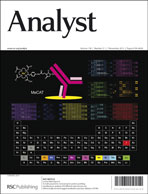Novel triazole-based fluorescent probes for Pd2+ in aqueous solutions: design, theoretical calculations and imaging†
Abstract
The first triazole-containing fluorescent probe with excellent water-solubility for Pd2+ was presented. The results indicated that an amide–triazole–amide binding sequence was responsible for the unique affinity of PS-1 toward Pd2+. Among the tested metal ions, only Pd2+ could selectively quench the fluorescence of PS-1 under physiological conditions, while other common interference ions like Pt2+ and Ru3+ caused little changes. The successful fluorescence imaging of Pd2+ in HeLa cells implied the potential applications of PS-1 in biological Pd2+-analysis.


 Please wait while we load your content...
Please wait while we load your content...